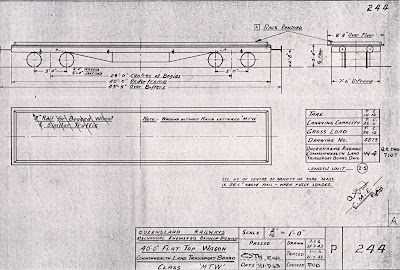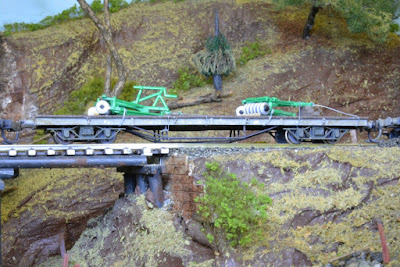Weekly
Notice 47/43 (25/11/43) advised that 55 “W” wagons would be converted to sheep
wagons, 50 NW double deck sheep wagons and 5 NWB sheep drover/guards vans. 1944
annual reported showed there were 356 “W”, 89 “MTW, 50 NW, 5 NWB’s were in
traffic. 1948 more wagons were
converted to NW wagons, in 1950, 50 were converted to WR rail wagons, more
followed in 1957. In 1957, 272 wagons were fitted with “Draft Gear” increasing
drawhook capacity, some were marked with CD in a side-on square on the sole
bar. Other just had the words “Draft Gear fitted. This made them “Select” or D3
drawgear, which allowed for increased train loads.
Photo Late Dr. Stephen Suggit (AMRA Qld Collection).
By
the mid 1950’s, wheat was being transported in new ‘WH” wagons in bulk. At about the same time, sugar was to be
transported in bulk. Boxes were placed on MTW wagons and carried bulk sugar to
port terminals at Mackay, Townsville and Cairns. This continued to the mid 70’s
when new PYC wagons were built for this traffic to increase loads etc. June
1960 Annual report showed 12 W wagons, as to 24 in 59, 436 MTW’s as to 398 in
59, this included 9 carrying bulk cement. 9 NW and 9 NWB’s in service. 120 WR
as to 70 wagons in 1959. Some WR were
made up into sets which were doubled coupled for conveying welded rail, these
wagons had a yellow band painted along the side and four extra bolsters. In the
late 60’s rail would arrive by ship docking at the BHP wharf at Hamilton. Rail
at the time was in 40 foot lengths, special trains would run from Whinstanes to
Banyo where the rail was welded into longer lengths.
NWB Drover/Guards Van
WR Coopers Plains.
MTW’s had a long record of service and over
time were converted to carry various traffic. 1981 CME report showed all but 15
of the original numbers were still in service.
WBC:- bulk cement (21). WM:- molasses (5 in 74
ND Tfc). MTWG :- bulk grain (17 in 79,
two types of containers), WRA:- (WR with ridge control bogies). WRB:- (in sets
of 5 to carry 24 m rail), KWA:- cattle wagon (100 in 77, ND Tfc), MTWC:-
Containers (1976), MTS:- steel floor (1989), MTSC:- steel floor- containers,
MTSF:- steel floor fast freight, these wagons were also fitted with bars for
carrying vehicles. WS timber, MMTW:-
maintenance wagons, some with mobile homes fitted. They were also used as
skeletal wagons for concrete bridge girders, 442 was fitted with cable drums
for electrification work.
MTW with sugar bins. Cairns. 1979
MTWC for Containers
WM molasses Townsville
WRA
WS
MTSF Bundaberg
MTSF 231 Clapham Jan 2000
KWA Partington Jul 99. (Ipswich Conversion)
KWA Garbutt Jul 99. (Townsville Conversion, QR 4 Bogies from HJSF Wagons)
“W/MTW’s’ wagons were painted red oxide (QR
goods wagon red) to 1969, and grey after that.
By 2000 only 3 remained in service.
MTW’s were used for everything, vehicles,
pipes, pineapple bins, circus trains, steel, timber to name a few, all you had
to do was work out how you were going to keep the load on the wagon during
travel.
On my 209 train where are two MTW s, both were
scratch build from styrene in about 1975, most likely my first wagons build
with this new material. Buffers:- 00 ERG (Bit oversize, all that was available
at the time), Bogies:- Turntable, one with K & M disc wheels, the other
with Steam Era spoke wheels. If construction today I would use Wuiske QRB009 or
Caintode Flats CFB 3 which are close to the mark if you have a few in the draw.
Queen posts for the trust rod are small fish hooks cut down. Before attaching
the load, you may consider weathering the floor. The grader load is a Woodland
kit (D234 - white metal), when attaching the plough blade, make sure it along
the grader so it fits on the wagon floor. The grader is secured by placing old
sleepers under the wheels both ends, pine chocks prevent the sleepers from
moving. Chain is added both ends. Various sizes of scale chains is available, I
make hooks from brass rod/wire to secure the chain to both the wagon and the
vehicle. The chain and hooks are secured with super glue and painted once the
glue sets. If glue gets on anything like the floor, it will dry shiny, dullcote
will fix that for you. This helps to keep the chain secured to the wagon when
handling. In most cases, the cab was
removed from the grader and secured to the floor, or placed in another suitable
wagon.
The second (grey) wagon is loaded with 2
ploughs, (Life-Like, Scene Master disc plows) these are not available today.
Keep your eyes open at “Buy and Sell” may find a couple at the right price.
Woodlands have two tractor and plough sets with different type ploughs which
would be still suitable (D207/AS 5564/AS 5565/D 208). The ploughs are secured
with old sleepers and wire. The wire is cotton from the CEO’s sewing
cabinet.
I wish acknowledge the following for prototype information.
Various
Weekly Notices,
Supplement
to Working Timetables,
QR
Rollingstock “Blue” Books,
QR
Plan Books,
General
Appendix’s,
Goods
and Live Stock Rates By-Law 1038 (1973)
Passenger Fares Book, By-Law No, 1139
(Passenger Trains),
ARHS
Sunshine Express,
ARHS
Bulletin
General
Iron
& Steel Wagons steam era by John Armstrong.





























